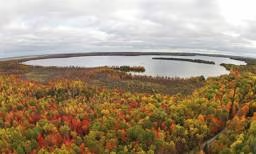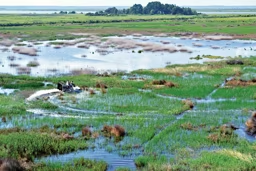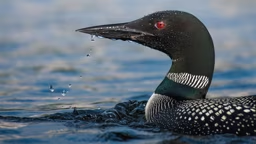More than 30 species of non-native aquatic invasive species are found in various areas of the United States. But three pesky species are found throughout the country: Eurasian watermilfoil, purple
loosestrife and curlyleaf pondweed.
Eurasian Watermilfoil
Eurasian watermilfoil is a submerged aquatic plant that grows in water depths from 1 to 15 feet or deeper. On the stems are whorled leaves with a featherlike appearance. Each leaf has 12 or more leaflet pairs. This characteristic can be used about 70 percent of the time to distinguish Eurasian watermilfoil from other milfoil species or hybrids. The flower spike sticks out of the water several inches from mid to late summer.
Detriments: Eurasian watermilfoil can mat at the water’s surface and can cause recreational nuisances. Fish do not seem affected.
Removal: The use of herbicides and/or harvesting are the typical methods of milfoil control.
loosestrife and curlyleaf pondweed.
Eurasian Watermilfoil
Eurasian watermilfoil is a submerged aquatic plant that grows in water depths from 1 to 15 feet or deeper. On the stems are whorled leaves with a featherlike appearance. Each leaf has 12 or more leaflet pairs. This characteristic can be used about 70 percent of the time to distinguish Eurasian watermilfoil from other milfoil species or hybrids. The flower spike sticks out of the water several inches from mid to late summer.
Detriments: Eurasian watermilfoil can mat at the water’s surface and can cause recreational nuisances. Fish do not seem affected.
Removal: The use of herbicides and/or harvesting are the typical methods of milfoil control.
Purple Loosestrife
Purple loosestrife is a perennial herb that grows 3 to 8 feet tall. It’s found in shallow water, wetlands, wet soils and even dry soils (in the past, it was planted in gardens). Leaves have smooth edges and are arranged opposite each other in pairs which alternate down the stem. Stems have four, five or six sides and are woody. Many individual flowers are found on a flower spike. Each flower has five or six pink-purple petals surrounding small, yellowish centers.
Detriments: Purple loosestrife can displace native sedges, grasses, and flowers – usually resulting in poorer food options and habitat conditions for wildlife.
Removal: The introduction of special beetles have been effective on infestations of several acres or more.
Purple loosestrife is a perennial herb that grows 3 to 8 feet tall. It’s found in shallow water, wetlands, wet soils and even dry soils (in the past, it was planted in gardens). Leaves have smooth edges and are arranged opposite each other in pairs which alternate down the stem. Stems have four, five or six sides and are woody. Many individual flowers are found on a flower spike. Each flower has five or six pink-purple petals surrounding small, yellowish centers.
Detriments: Purple loosestrife can displace native sedges, grasses, and flowers – usually resulting in poorer food options and habitat conditions for wildlife.
Removal: The introduction of special beetles have been effective on infestations of several acres or more.
Curlyleaf Pondweed
Curlyleaf pondweed is a submerged aquatic plant that grows in 1 to 2 feet of water out to depths of 15 feet or deeper. Leaves are about 3 inches long and have serrated (toothed) edges while the leaf margins are wavy or curled. Leaves alternate on the stem. Flower stalks stick up above the water surface in June. Burr-like winter buds (turions) are produced on the stems before the plant dies back.
Detriments: Curlyleaf pond-weed can grow quite dense causing recreational nuisances. When it dies back in mid-summer and releases nutrients, they may contribute to algae blooms.
Removal: As with milfoil, the use of herbicides and/or harvesting are the typical control methods.
Steve McComas, an aquatic scientist who owns Blue Water Science, is always on the lookout for non-native plants lurking in our waters.
Curlyleaf pondweed is a submerged aquatic plant that grows in 1 to 2 feet of water out to depths of 15 feet or deeper. Leaves are about 3 inches long and have serrated (toothed) edges while the leaf margins are wavy or curled. Leaves alternate on the stem. Flower stalks stick up above the water surface in June. Burr-like winter buds (turions) are produced on the stems before the plant dies back.
Detriments: Curlyleaf pond-weed can grow quite dense causing recreational nuisances. When it dies back in mid-summer and releases nutrients, they may contribute to algae blooms.
Removal: As with milfoil, the use of herbicides and/or harvesting are the typical control methods.
Steve McComas, an aquatic scientist who owns Blue Water Science, is always on the lookout for non-native plants lurking in our waters.













